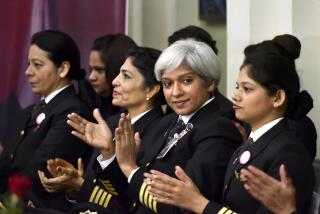Special Programs Can Help Women Abandon the Galley, Take to the Tiller
- Share via
Bernadette Bernon, editorial director of Cruising World and Sailing World magazines, is leaving her job so that she and her husband, Douglas, can go sailing for the next few years. They plan to head off from their Newport, R.I., home this spring and sail to Maine and Canada’s Nova Scotia, tuck into Chesapeake Bay during the summer hurricane season, then move on to the Caribbean and South America. From there, they’ll cross the Atlantic or venture into the Pacific as the spirit moves them.
“I’ve never found a better way to travel,” Bernon says.
It sounds like pure magic: arriving in new places by boat, living for a spell in remote harbors that land-loving travelers seldom visit, and feeling at home in your vessel wherever you drop anchor.
The trouble is I don’t know how to sail, even though I used to spend most of my vacations on Cape Cod, Mass., where I received instruction on at least two dozen occasions from one seafaring man or another. But I am still fuzzy about the difference between jibing and tacking, can’t tie a half hitch and get painfully embarrassed when the call of nature forces me to go below deck to use the facilities. (In this regard, men are better equipped than women for sailing.)
According to Doris Colgate, the author of “Sailing: A Woman’s Guide” (Ragged Mountain Press, $14.95) and president of the Fort Myers, Fla.-based Offshore Sailing School, I’m not the only woman who would love to sail the world but hasn’t been able to acquire the skills. Fortunately, sailing programs for women, like Colgate’s weeklong “You Can Sail Escapes” (which include classes, certification and accommodations in places like the Florida Keys), let us learn by doing, with no men around to take the tiller away when the going gets rough.
“It’s hard to let your guard down and make a mistake with a man on board,” Colgate says. In a safe, supervised women-only instructional setting, “so what if you jibe instead of tack?” she asks.
I like the sound of that, partly because I think women and men have different learning curves. The way the two sexes learn to sail seems a prime example.
“Men usually have no problem jumping on a boat and figuring out how it works,” says Barbara Marrett, an experienced sailor from Friday Harbor, Wash. Most women want someone to explain things carefully and fully before they climb on board.
These differing approaches can lead to problems when a woman tries to learn sailing skills from a boating enthusiast who is also her boyfriend or husband. Even though the male teacher may mean well, the female student often winds up feeling sidelined and frustrated, eventually returning to the galley to make coffee or simply giving up. Suzanne Pogell, founder of Womanship, a sailing and cruising school for women with headquarters in Annapolis, Md., says her programs “have saved a lot of relationships.”
Marrett married a sailor who asked her on their first date whether she wanted to cruise to Easter Island, more than 2,000 miles off the coast of Chile. They tied the knot, then headed down the California coast a year later, fought through a hurricane off western Mexico and checked out the Galapagos Islands before reaching Easter Island.
But even after the yearlong trip, Marrett still didn’t really know how to sail, she says. So she started from scratch, taking lessons on a shallow lake with a community sailing group that included lots of kids. (“Learning to sail as a child is easier,” she says, “like skiing.”) Her skills are now solid enough to have won her the first mate spot this summer on an 18-day women-only sailing adventure from Hawaii to the San Juan Islands of Washington.
The trip, sponsored by Orange Coast College Sailing Center in Newport Beach aboard the center’s 65-foot flagship, Alaska Eagle, is mainly for experienced sailors. But throughout the year, the center offers classes on sailing basics aimed at women. Other attractive women’s sailing programs include:
* “Take the Helm” weekends, sponsored in different ports around the country (for instance, Seattle on May 19 and 20) by the National Women’s Sailing Assn.
* The Women’s Sailing Assn. of Santa Monica, which offers weekend, live-aboard trips to Catalina Island, Redondo Beach, Malibu and Ensenada, Mexico.
* Women’s Sailing Week Dec. 2 to 9 at the Bitter End Yacht Club on Virgin Gorda in the British Virgin Islands, where champion sailors like Betsy Alison, four-time Rolex Yachtswoman of the Year, help novices learn the basics and those with more experience perfect their skills.
Many old salts think women make better sailors than men in some ways. Colgate says women are better able to concentrate on several things simultaneously, which comes in handy on the water. Moreover, once we learn to sail, women tend to steer with great intuitiveness and sensitivity, which is encouraging. It’s so encouraging that maybe I’ll try again.
National Women’s Sailing Assn., telephone (800) 566-6972, Internet https://www.sailnet.com/nwsa.
Offshore Sailing School, tel. (800) 221-4326, Internet https://www.offshore-sailing.com.
Orange Coast College Sailing Center, tel. (949) 645-9412, Internet https://www.occsailing.com.
Womanship, tel. (800) 342-9295, Internet https://www.womanship .com.
Women’s Sailing Assn. of Santa Monica Bay, tel. (310) 641-6445, Internet https://hometown.aol.com/ mgaggie/wsa.html.
Women’s Sailing Week at Bitter End Yacht Club, tel. (800) 872- 2392, Internet https://www.beyc .com. (Package, including accommodations, meals, transfers and classes, $1,925 per person, $2,800 for two.)
More to Read
Sign up for The Wild
We’ll help you find the best places to hike, bike and run, as well as the perfect silent spots for meditation and yoga.
You may occasionally receive promotional content from the Los Angeles Times.






